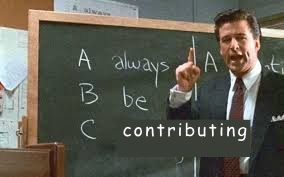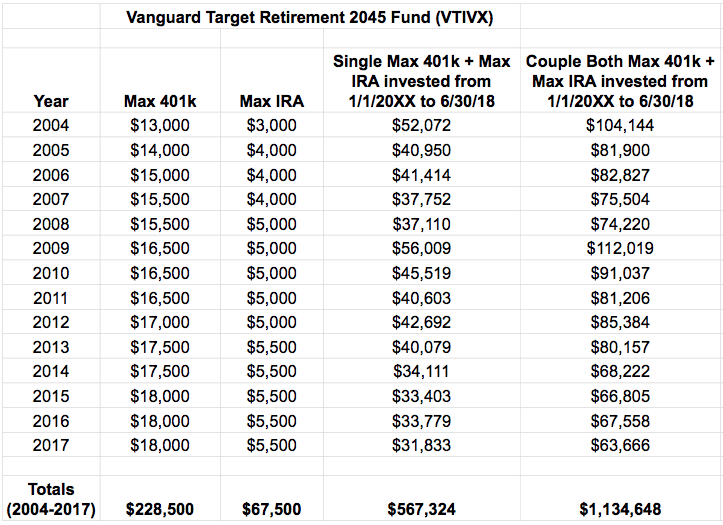 Like many others, I had a vague goal of $1 million net worth in my 20s. It’s easy to find a theoretical path a million. For example, $750 per month earning 8% returns for 30 years with get you there. Doing the actual earning, saving and investing is the hard part. It gets even harder during a bear market when your money feels like it is burning up in flames.
Like many others, I had a vague goal of $1 million net worth in my 20s. It’s easy to find a theoretical path a million. For example, $750 per month earning 8% returns for 30 years with get you there. Doing the actual earning, saving and investing is the hard part. It gets even harder during a bear market when your money feels like it is burning up in flames.
On the list of “Things I Would Tell My Younger Self”, I would include “Be patient and keep saving. You’ll get there.” Or by changing up the phrase “Always Be Closing” popularized in Glengarry Glen Ross – “Always Be Contributing” (ABC). One of the major benefits of writing this blog was keeping my focus on this path.
This is how a real couple could have gone from zero to $1 million from 2004 to 2017. My spouse and I both had our first full year of full-time jobs in 2004. From 2004 to 2017, we contributed the maximum allowable limit to both of our 401k and IRAs each year. The contribution limits rose gradually over the years. (Company match is not included here.) We invested our money in low-cost index Vanguard funds – mostly stocks with a little bonds – which can be closely approximated by the Vanguard Target Retirement 2045 fund (ticker VTIVX). This fund had its share of ups and downs with the market. It crashed a lot in 2008 and 2009. It went back up a lot afterward. We just kept contributing and buying each year.
Using Morningstar tools, I found the final amount today if the limit was invested on January 1st of each year. For example, if both of us invested $16,000 in Vanguard Target Retirement 2045 at the beginning of 2004 ($13k + $3k), that investment would now be worth $104,144 as of June 30, 2018. And so on for each subsequent year. As you can see, if you add all the years up, you would reach over $500,000 for an individual and over $1,000,000 for a couple:

These numbers won’t be the same across other time periods, but they do represent a real-world experience. I’ve done a variation of this before in What If You Invested $10,000 Every Year For the Last 10 Years? 2008-2017 Edition.
According to Vanguard, 13% of their plan participants maxed out their 401k plans in 2017. 58% of participants had their entire account balance invested in a single target-date fund or similar managed allocation.
Bottom line. A real couple that started saving as 26-year-olds in 2004 and maxing out both their 401k and IRA plans each year could have reached $1 million by age 40 in 2018. All with a simple Vanguard Target Retirement index fund. This requires a lot of steady saving, but the important part is that it required no special investment skill. You didn’t need to recognize bubbles. You didn’t need to time bottoms. You didn’t need a fancy asset allocation, estimate future cashflows, understand price/book ratios, or even rebalance. Always be contributing.
 The Best Credit Card Bonus Offers – 2025
The Best Credit Card Bonus Offers – 2025 Big List of Free Stocks from Brokerage Apps
Big List of Free Stocks from Brokerage Apps Best Interest Rates on Cash - 2025
Best Interest Rates on Cash - 2025 Free Credit Scores x 3 + Free Credit Monitoring
Free Credit Scores x 3 + Free Credit Monitoring Best No Fee 0% APR Balance Transfer Offers
Best No Fee 0% APR Balance Transfer Offers Little-Known Cellular Data Plans That Can Save Big Money
Little-Known Cellular Data Plans That Can Save Big Money How To Haggle Your Cable or Direct TV Bill
How To Haggle Your Cable or Direct TV Bill Big List of Free Consumer Data Reports (Credit, Rent, Work)
Big List of Free Consumer Data Reports (Credit, Rent, Work)
My assumption is your achieving this goal prompted you to write this post. So congratulations on sticking with it and making it to this point. Good job. I’ve enjoyed reading your blog for about the last 8 or 9 years and am happy for you.
Thanks for reading all these years!
Congratulations! Another evidence for showing “slow and steady” is the key. A bit off topic, but do you still do a “backdoor” Roth IRA or just keep in traditional IRA? Thanks!
We have been doing the “backdoor” Roth IRA the past few years.
Jonathan, thank you for another interesting post. Here’s a tip I used that might be of interest to your other readers. Those who invest in equities in retirement accounts do so with the belief that the stock market will go up.
That being said, it makes sense to fund 401k’s and IRA’s as early in the year as possible. So, in my later working years, when I had accumulated some savings, I would fund my IRA’s Jan. 2, and would have my company withhold 90% of my pay (10% for taxes) as my 401k contribution. I would then live off of my savings accounts until I maxxed out on contributions…usually by late March, early April.
Then for the rest of the year, as I was getting “full” paychecks, I would use some of that money to re-fund my savings account to do it again the following year.
I believe it made a difference as I was able to retire on a “middle class” income at age 52, eight years ago.
Wow, that’s some commitment. We mostly just try to max things out by October or November, such that there is no miscalculation and we are sure to reach the max. Our income can be somewhat variable throughout the year.
Thanks for the comment. I am aware of “front loading” which I have been doing for a couple of years for IRAs. My employer’s 401k match is spread over 12 months (24 biweekly paychecks) so that strategy does not work.
This is an old post, but you should ask about “true up” contributions:
Strategies For Maxing Out Your 401k/403b and Company Match, True-Up Contributions
Thank you, Jonathan. I’ll read and contact our HR/benefits manager.
That’s also a great strategy for HSAs!
Is this the most tax effective strategy? Won’t taxes at time of withdrawal take large bites out of returns?
Well, this doesn’t assume pre-tax or post-tax. You could contribute the max to a 401k or Roth 401k, Traditional IRA or Roth IRA. The Roth versions will require more post-tax money, but will not incur taxes on the way out.
If you did do all pre-tax, it would still depend. When you contribute to a pre-tax account, you’ll save at your marginal tax rate. However, when you withdraw you might have a lot of room left in your standard deduction such that you would have a lot of money at a 0% tax rate. For 2017, the first $24,000 of income would be tax-free. More here:
https://www.mymoneyblog.com/2018-irs-federal-income-tax-brackets-example-married-no-kids.html
We personally did a mix of pre-tax and post-tax Roth. This can actually optimize your taxes as you can use up your 0% tax rate space, and then use Roth money withdrawals after that.
Can you point us to more writing about savings allocation, beyond the basics of “max everything out” and that doesn’t assume access to a Roth 401k? My company is not looking out for us so they haven’t offered a Roth 401K as an option. And assuming nothing forces early retirement, I expect social security to exceed $2000/month, which would exceed the 0% income bracket, and that’s even before accounting for RMD from tax-deferred accounts. Some less mainstream authors talk about using insurance as a vehicle to shield income from RMD and tax altogether, but the murky world of permanent life insurance and the lack of performance disclosures makes me wary, but at the same time there doesn’t seem to be an option to shield enough retirement income from taxes if we don’t have a Roth 401k.
Its not just taxes will take a bite out of returns. Inflation will too! 13 years form now you will not have a million dollars in 2017 purchasing power.. but rather in 2030 purchasing power.